We will discuss how to read a motor nameplate data and the motor data interpretation. The motor manufacturers displays the data on nameplate differently. sometimes the nameplate becomes dirty and data is not readable.
There are several international standards for a motor. The NEMA and IEC are two important standards. NEMA is popular in North America and IEC is in the rest of the world.
NEMA standard specifies motor power in hp (Horsepower), whereas the IEC standard specifies power in kW(Kilowatt).
Motors are the heart of modern machines. Therefore, it is necessary to know their fundamental operating principles, from construction to their applications.
In that order, the manufacturers provide some characteristic data on motor plate. We call this plate as a nameplate or number plate of motor. The nameplate shows important design and operating data of the motor.
Motor number plates are of great importance because,
- Helpful to maintain the working characteristics for motor data recovery.
- The mechanical and electrical data are necessary since with these data it will be possible to design and to provide protection to the motor.
- We use these types of equipment widely in the various areas of modern life both in housing, commerce, and industry.
Electric Motor-Number Plate
Each rotating electrical machine must be provided with a plate and this is nothing more than the identity document of the electric motor. Manufacturers follow according to established standards (NEMA or IEC) with which the manufacturer elaborated and must show the data that identifies for its correct operation. The nameplate should be robust. These plates must be made of a durable material and mounted securely enough on the casing (Motor body).
Interpretation of Motor Nameplate Data
In order to explain how to interpret a nameplate, it is very important to know the meanings of each of the electrical acronyms contained in an identification plate that electric motors have. We will use the motor nameplate of a three-phase motor shown below in our explanation.
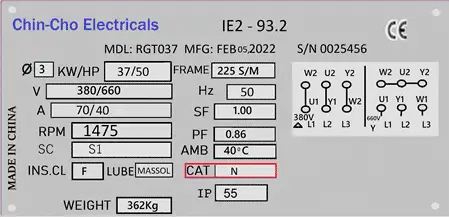
We can easily understand the motor nameplate data, and there involves is no typical terminology.
Description of the meaning of each field on a motor nameplate
1. Number of phases
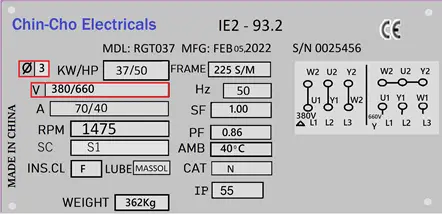
This data indicate the number of phases that the motor needs for its operation. In this case, the motor is a three-phase alternating current.
2. Nominal operating voltages
The voltage data engraved into the motor nameplate is the operating voltage of motor. Many industrial motors may have more than one voltage (line power) for its operation.
For example, (380/660V) motor nameplate data shows the nominal voltages that the motor needs for its operation. We can operate the motor either at 380 volts or 660 volts.
Motors generally have a tolerance of 10% ± of nameplate rated voltage. The motor performance remains the same if the operating voltage is in the range of rated voltage +/- 10 % of the rated voltage. For example, a 440 volts motor can reliably function in the range of 440 +/- 44 = 396 Volts to 484 volts.
3. Efficiency of the motor
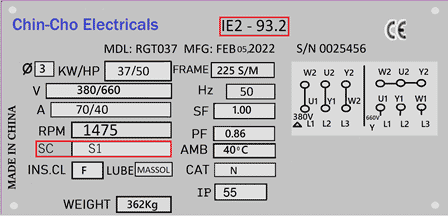
The efficiency rating of a motor shows how effectively motor converts electrical energy into mechanical energy. The efficiency classes of motors are IE1,IE2,IE3 & IE4. IE4 class motor is the most efficient motor. It has very low losses.
The efficiency of the motor depends on the percentage loading on motor. We can improve the motor efficiency by lowering the losses like copper, iron, stray & friction losses.
4. Service Class
The motor can be subjected to various working conditions with respect to the operating time and the stop time. A series of standardized “Service Classes” indicates the permissible load that a motor can continuously deliver to driving equipment.
For this example motor, it is S1 which means a work regime with constant load or for indefinite work time. The motor of S1 class duty delivers the continuous torque to mechanical load. Also, there are other classes of motor according to applications.
5. Size of the casing (Frame Size)
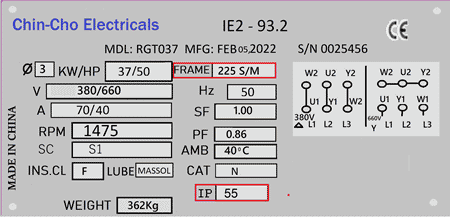
We can identify the major motor dimensions with the frame size of the motor. The frame size of the motor depends on the motor speed and the service duty of the motor. For example, the frame size 225S/M shows that the height (H) of the motor shaft from its base is 225 mm. S/M shows the motor is have two types of mounting holes. And, we can fit the motor on the base frame that has holes as per the S & M dimension of the motor.
Low RPM motor has more number of poles and draws large magnetizing current. That is why low RPM motor has bigger frame size.
6. Degree of protection (IP55)
Degree of protection indicates the motor protection against the entry of foreign bodies (dust, fibers, etc.), accidental contact, and penetration of liquids (water).
For example, the installations where there is chance of water entry into the motor. the motor should have that degree of protection. The motor terminal box, motor body and other parts of the motor must be capable to withstand such jets, under certain pressure values and angle of incidence, without the penetration of water that impairs the operation of the motor.
An IP55 rated motor has protection against dust ingress. It has protection against solid objects and water jets projected by a nozzle (6.3mm) from any directions.
The other classes of ingress protection are IP44, IP54, IP65, IP66, IPX4, IPX5 and IPX7.
7. Frequency
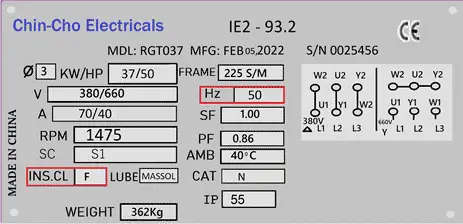
The frequency is the the rate at which something occurs over a particular period of time. The speed of the motor is proportional to the frequency.
The usual frequency of the power supply system is 50 Hz. However, in some parts of world it is 60 Hz. In North America the standard frequency is 60 Hz.
In the above motor nameplate, 50HZ is the frequency applicable for this motor.
You will find multiple frequency ratings on some motor nameplates.
8. Insulation class
The insulation class indicates the operating temperature of the insulating materials used in the motor winding. The most common insulating materials are B.F and H type. The F class insulation can withstand more temperature in comparison to B class insulation. The H class insulation has the highest temperature withstand capability.
For example, Class F means that the winding of this motor supports a temperature of up to 155°C.
9. Nominal power of the motor
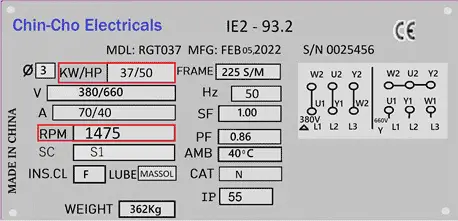
(KW 37 and HP 50)- It is the force that the motor generates to move the load at a certain speed. This force is measured in HP (horsepower), or KW (Kilo Watt).
10. Nominal speed of the motor in RPM
It indicates the revolutions per minute of rotor. It is the actual speed of the motor at 100% loading. The speed of the motor depends on the frequency of the line voltage and the number of poles on the motor.
The manufacturer shows the actual speed of the motor on the nameplate. The speed mentioned on the nameplate is somewhat less than the synchronous speed of the motor. The difference in the actual speed and the synchronous speed is because of slip of the motor.
11. Nominal operating current
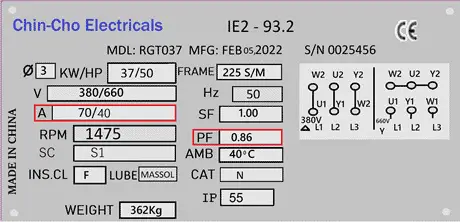
It is the current that the motor absorbs from the network when it works at nominal power, its nominal voltage, and frequency.
The value of the nominal current depends on the performance and power factor of the motor: In this case, it is 70.1A, nominal current for 380V, and 40.4 A nominal current for 660V; A= means Amps.
The nominal current is also expressed as FLC or FLA on the nameplate.
12. Power factor
Indicates the value of the motor power factor, that is, the relationship between the active power (KW) and the apparent power (KVA). The electric motor absorbs active energy (Which produces useful power) and reactive energy (necessary for the magnetization of the winding).
The value of the power factor of the machine for this case is 0.86.
13. Maximum ambient temperature
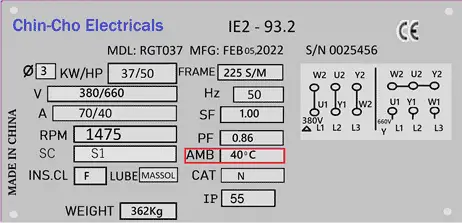
This means the maximum ambient working temperature of the motor, most motors are designed for 40°C.
14. Motor weight
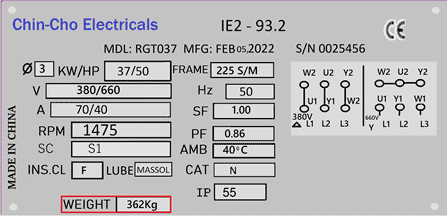
362 kg this indicates the weight of the electric motor.
15. Front bearing Number
DE(Driving end) side bearing
16. Rear Bearing Number
NDE( Non driving) side bearing
17. Types of bearing grease
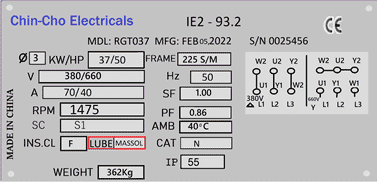
The type of grease used in the bearings is specified here. (MASSOL)
18. Connection diagram
It shows how to connect to a motor, to be carried out accordingly. Only qualified persons are supposed to do connections. Improper connection leads to damage.
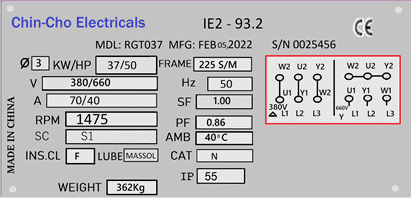
19. Date of manufacturing
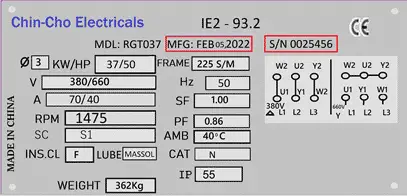
It was manufactured on February 05, 2022.
20. Serial number
It is the serial code with which the electric motor is identified.
21. Torque category

The load demand typically higher starting torque than the motor rated torque. For example, two motors of the same torque values may not be suitable for a particular application. This is because of different starting torque requirement. For example. the torque requirement of the centrifugal pump is different than the starting torque requirement of a conveyor.
This parameter is expressed with CAT N which indicates that this motor was designed to work with normal loads, for example, pumps, fans, conveyor belts, etc., The following letters are used for the types of loads.
- Design letters B (normal starting torque)
- C (high starting torque)
- D (very high starting torque)
22. CT/VT
You may find the CT/ VT engraved into the motor nameplate.
- CT – Constant Torque
- VT – Variable Torque
These data are mostly available on motor nameplate for an inverter duty motor.
Read Next:
Very helpful.
Need more related notes